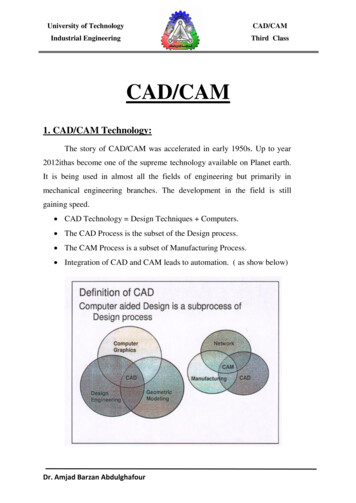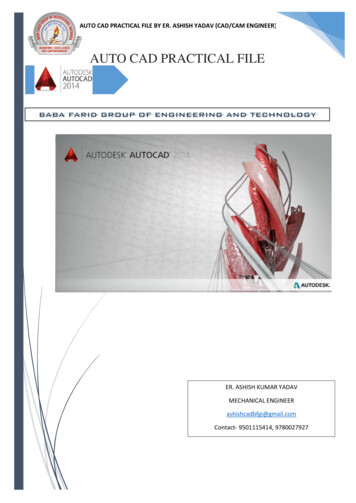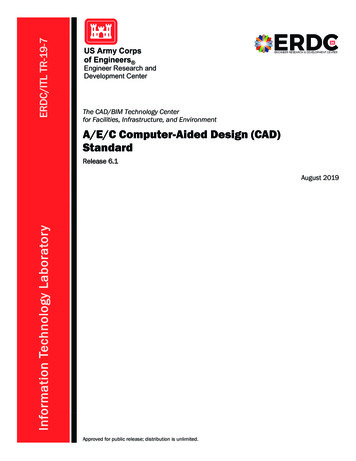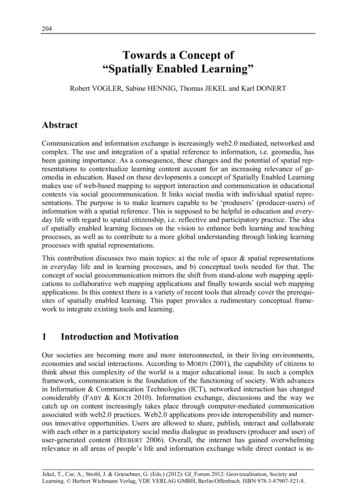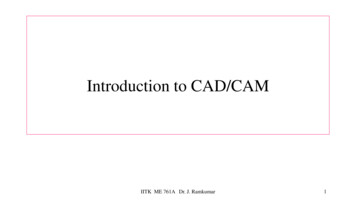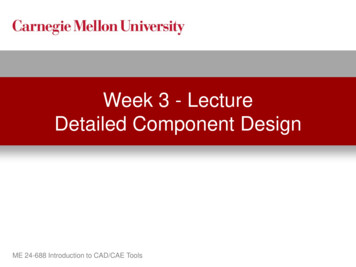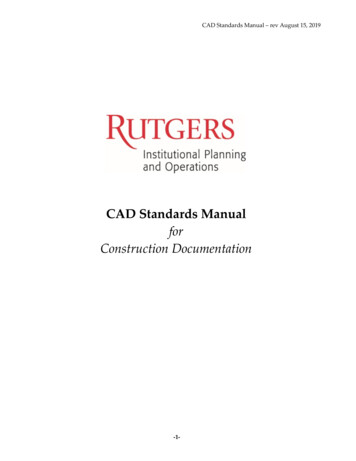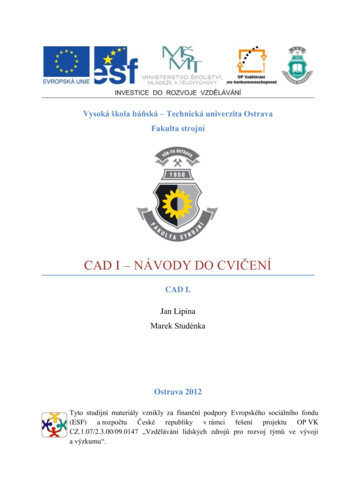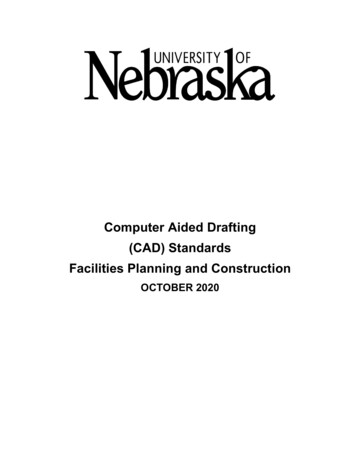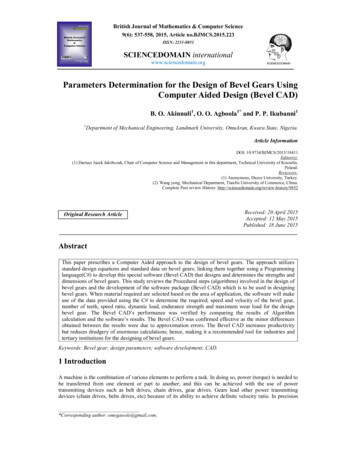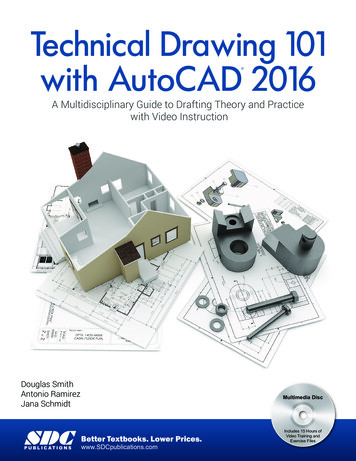
Transcription
Web-enabled model-based CAD for designJ.C.P. ChengStanford University, USAY. ZhangTsinghua University, ChinaC.S. Han & K.H. LawStanford University, USAB. KumarGlasgow Caledonian University, UKAbstractIncreasingly innovative ways of exploiting the Internet is giving rise to potentially new ways ofdesigning and managing constructed facilities. The ability to source design components from differentlocations on the web and incorporate them in developing a design solution is an evolving technologythat would have major implications for the way design and construction are carried out. Many CADapplications have developed user interfaces and connectivity supports that enable the incorporation ofonline information and web applications in a convenient manner. Building information modeling isanother promising technology that facilitates knowledge management and collaboration amongstakeholders throughout the design, construction, and maintenance operations. In a buildinginformation model, each component has its properties, information, and semantics. Applicationprogramming interfaces (APIs) in CAD software can be used to facilitate the management andexchange of building information. Therefore, a CAD application can become a service hub foracquiring and capturing design and project information.This paper describes an effort in applying web-enabled technologies using both software AutodeskArchitectural Desktop (ADT) and Google Sketchup. Three scenarios will be illustrated to show thepotential of web-enabled model-based CAD in the design and construction processes. The firstscenario demonstrates the usage of CAD programs to perform configuration design by directlyinteracting with the web and online information through web browsers and a CAD software plug-innamely SpecifiCAD. The second scenario illustrates the evaluation of design alternatives according toenergy and carbon emission simulation and analysis results, provided by using a Sketchup plug-in thatlinks to the Integrated Environmental Solutions (IES) software. The third scenario shows theutilization of the entity information from CAD models to facilitate project planning and control withsuppliers.Keywords: CAD, Web-enabled, Design, Construction, BIM.1IntroductionComputer-aided design (CAD) applications have been widely used in the construction industry as atool to aid architectural design, to visualize the physical appearance of a building, and to specifydesign details for construction processes. Many of them have application programming interfaces(APIs) to enable extension of application functionalities. For example, users can executeprogramming scripts through APIs to automate the drawing and conformance checking of buildingcomponents.
Current CAD programs are mostly standalone. With the emerging Internet infrastructures andtechnologies, buildings can be designed and constructed in a more co-operative manner. The growingtrend of CAD drawings supported by building information models also provides much potential forintegrated design and construction among scattered stakeholders. In this paper, we describe a fewexamples to demonstrate the potential applications of web-enabled model-based CAD for design,procurement, and project management.2Web-enabled model-based CAD2.1Integrating online information and web applicationsThe Internet has been leveraged to build an environment that connects distributed CAD softwareclients to a centralized product data server for collaborative design (Fuh and Li, 2005; Han et al.,1999; Zhuang and Chen, 2000). In this paper, we demonstrate the use of the Internet technologies toexplore and retrieve information available on the web, and to integrate distributed applications asweb-based services within CAD programs. Figure 1 shows a conceptual representation of webenabled model-based CAD applications. The ability to source design components from differentlocations on the web and incorporate them in developing a design solution could greatly impact theway design is developed and create many business opportunities. There have been growing interestsin integrating and interaction with online information among CAD vendors. For example, the i-droptechnology developed by Autodesk and the drag-and-drop capability of Google Sketchup userinterface enable a designer to ‘pull’ an object (e.g. door, window, chair, etc.) over the web anddirectly drop them into a CAD design. These technologies not only allow designers to create andchange a design easily and quickly, but also enhance the communication among the designers,manufacturers and suppliers within the construction industry.2.2Model-based framework for information repository and managementTraditionally, a design is drawn using a combination of geometric entities such as lines, planes, andvolumes. This geometry-based approach is now evolving to an object-oriented model-based approach,in which each design object component (e.g. door, wall, and slab) has its properties, information andsemantics (Eastman et al., 2008). The sets of properties and semantics affect the operations on theobject in a model-based CAD software application. The object properties and information can also bemanipulated by other software applications and can further be utilized throughout the project lifecycle. The component information such as product data, supplier information, and scheduleinformation is stored and managed at the back end, in a database or inside the CAD drawings. Thisinformation can facilitate decision making, production of construction documents, prediction ofbuilding performance, cost estimating, and construction planning. Therefore, a CAD application canbecome a service hub for acquiring, capturing and managing design and project information.InternetAPIsCAD applications Software programsFigure 1. Web-enabled model-based CAD applications.BuildingInformation Software programs
3Example scenarios3.1Example 1: configuration design and procurementAlthough buildings have different shapes and designs, many of them share similar buildingcomponents. In configuration design, parts are selected and connected to meet customer specificationsand engineering and physical constraints (Darr et al., 1998). The i-drop technology developed byAutodesk and the graphical user interface in Google Sketchup allow users to drag-and-drop contentsfrom the web to a CAD drawing. As shown in Figure 2, architects can choose a specific product itemfrom online catalogs and drag-and-drop the product model as well as the associated information toCAD software programs, using Autodesk i-drop technology. The catalogs can be either publiclyaccessible or password protected. In password protected catalogs, suppliers can show differentchoices of items with customized price information. The HTML web page is modified and enhancedas an XML file, which includes the location of the product and the information, such as product codeand supplier information, about the product. The product information in the CAD drawing can then beextracted to Microsoft Excel through API to create an item list for final checking before procurement.Dynamic catalogs can also be created. In this example, we leverage SpecifiCAD developed byCADalytic, Inc. to provide connectivity and interaction between CAD object components and the webwithin Autodesk ADT and Google Sketchup. As illustrated in Figure 3, when a designer clicks awindow in Sketchup and selects the “catalog” option in SpecifiCAD, a list of window alternatives isshown. In fact, since the component name contains the word “window,” the program searches withinthe extranet all the windows from partnering suppliers and obtains the product and contactinformation through the suppliers’ web services. The architect can drag-and-drop from the dynamiccatalog and insert a new object in the CAD drawing. The architect can also click the hyperlink “Ourreplace tool” to show an interface that allows all the window components to be replaced in the CADprograms with the alternative from the catalog. The component properties, information, and displayare updated automatically.Online catalog[Autodesk i-drop]Procurement list[MS Excel]XML package file: ?xml version ”1.0”? packagexmlns ”x-schema:idrop-schema.xml” proxy defaultsrc ”data/bed1.jpg” /proxy dataset defaultsrc ”Portrait K1456.max” datasrc clipformat ”CF IDROP.max” datafile src ”IK-CA-0789.max”/ /datasrc datasrc clipformat ”CF IDROP.dwg” datafile src ”IK-CA-0789.dwg”/ /datasrc /dataset /package Architectural drawing[Autodesk ADT]Figure 2. Drag-and-drop web contents to CAD drawings using Autodesk i-drop technology for design andprocurement.
Architectural drawing[Google Sketchup]Dynamic catalog[SpecifiCAD]Figure 3. Interaction between CAD object components and dynamic online information.3.2Example 2: building performance analysisBesides geometry, model-based CAD drawings also contain building component information whichcan be utilized for simulation and analysis of building performance. In this example, IntegratedEnvironmental Solutions (IES) Virtual Environment is used to simulate and evaluate the energyconsumption and carbon emissions of a building within Google Sketchup. Before simulation, IESVirtual Environment extracts the information from the Sketchup drawing and identifies individualrooms (Figure 4). Room types such as “dining area” and “bedroom” can be defined using the interfaceprovided by the IES plug-in. The size and property definitions of the rooms and of the componentssuch as windows and doors are then transferred to IES Virtual Environment. With reference to localclimate data, the program estimates the annual carbon emissions and energy use.IES Virtual EnvironmentTotally 8 roomsRoom propertiesComponent propertiesRoom 8Room typedefinitionAreas (ft2) of floor, wall,and glazed areasFigure 4. Energy and carbon emissions analysis of a building.EnergyHeatingCoolingLightsEquipmentTotal (MBtu/yr)Percentage43%7%13%37%54.85Carbon emissions: 6.2 tons CO2/yr
(a) Original model(b) Double glazed windowsreplaced with triple glazed onesEnergyHeatingCoolingLightsEquipmentTotal (MBtu/yr)(a)23.6 43%3.87%7.1 13%20.3 37%54.8 100%(c) Replaced with larger windows(b)24.3 47%1.63%7.3 14%18.6 36%51.8 100%(c)23.9 41%5.8 10%7.0 12%21.6 37%58.3 100%(d)24.1 46%2.14%6.8 13%19.4 37%52.4 100%(d) Windows on the sides and at theback are removedFigure 5. Comparison of different architectural designs in terms of energy use.Web-enabled configuration design described in Section 3.1 can be used to facilitate the generation ofvarious architectural designs. Designers can conveniently modify a design and evaluate its buildingperformance before procurement. For illustration, Figure 5 shows the comparison of energy useamong four architectural design alternatives, and thus provides valuable information regarding thecost to replace double-glazed windows with triple glazed ones.3.3Example 3: project planning and controlWhile CAD applications are often used for architectural design, they can also be used for projectplanning and management. With model-based CAD that include back-end building information suchas schedule information, the project manager can submit a query and view the building componentsinvolved in the activities within a specified period, as illustrated in Figure 6. The project manager canutilize this information for planning and management purposes.We leverage the SpecifiCAD interface to show the back-end building information model and tointeract with web applications within Autodesk ADT. For example, when the user clicks a window inADT and selects the “schedule” option in SpecifiCAD, the schedule information of the windowcomponent is shown. In addition, the user can initiate material delivery by clicking the “ShippingRequest” button, which invokes the web services deployed in the supplier’s management system. Thisallows a “pull” strategy for just-in-time delivery. As a result, the delivery schedule becomes adaptableto the exact site situation and minimizes on site inventory.4Summary and discussionThis paper has presented three example scenarios that demonstrate the potential of web-enabledmodel-based CAD for architectural design and project planning. The ability to integrate CAD modelwith web contents, the building information models, and API supports make CAD applications more
extensible, flexible, and accessible. CAD systems can serve as an interactive tool for informationmanagement, communication and collaboration, and construction planning, operations andmaintenance. Further research is needed to address the issues such as information concurrency andconsistency, security, and data semantics to enhance the usability of web-enabled model-basedapplications.AcknowledgementsThe authors would like to acknowledge the supports by the US National Science Foundation, GrantNo. CMS-0601167, the Center for Integrated Facility Engineering (CIFE) at Stanford University, theEnterprise Systems Group at the National Institute of Standards and Technology (NIST) and theUndergraduate Visiting Research Experience (UGVR) Program at Stanford University. Any opinionsand findings are those of the authors, and do not necessarily reflect the views of NSF, CIFE, NIST orthe UGVR Program. No approval or endorsement of any commercial product by NIST, NSF orStanford University is intended or implied.ReferencesDARR, T., KLEIN, M. and MCGUINNESS, D.L., 1998. Special Issue: Configuration Design. Artificial Intelligence forEngineering Design, Analysis and Manufacturing, 12 (04), 293-294.EASTMAN, C., TEICHOLZ, P., SACKS, R. and LISTON, K., 2008. BIM Handbook: A Guide to Building InformationModeling for Owners, Managers, Designers, Engineers and Contractors. New Jersey: Wiley.FUH, J.Y.H. and LI, W.D., 2005. Advances in collaborative CAD: the-state-of-the-art. Computer-Aided Design, 37 (5), 571581.HAN, C., KUNZ, C.J. and LAW, K.H., 1999. Building Design Services in a Distributed Architecture. Journal of Computingin Civil Engineering, ASCE, 13 (1), 12-22.ZHUANG, Y. and CHEN, L, 2000. Cybereye: an Internet-enabled environment to support collaborative design. ConcurrentEngineering, 8 (3), 213-229.Floor 3BuildingInformation2 weeksCAD drawings[Autodesk ADT]SQLSELECT *FROM scheduleWHERE (start ‘200903-31 00:00:00’ AND start ‘2009-04-11 11:59:00’)Figure 6. Model-based CAD model in Autodesk ADT for project planning and control.Scheduleinformation[SpecifiCAD]Supplier
consumption and carbon emissions of a building within Google Sketchup. Before simulation, IES Virtual Environment extracts the information from the Sketchup drawing and identifies individual rooms (Figure 4). Room types such as "dining area" and "bedroom" can be defined using the interface provided by the IES plug-in.

